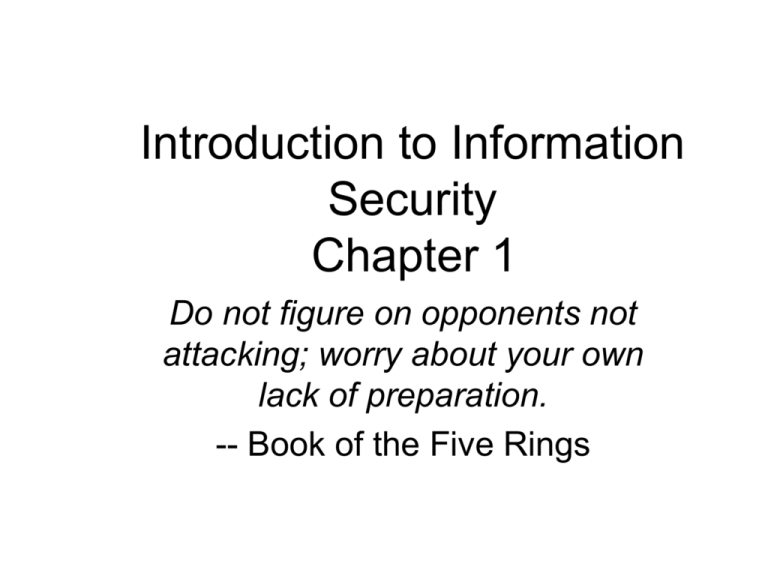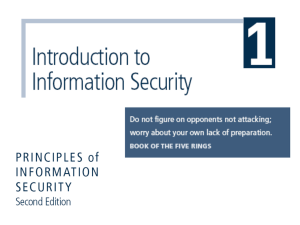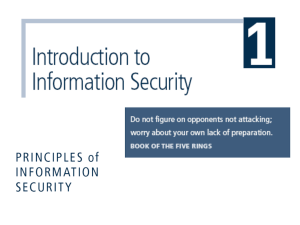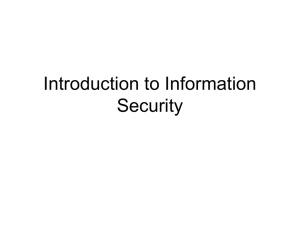Introduction to information security
advertisement

Introduction to Information Security Chapter 1 Do not figure on opponents not attacking; worry about your own lack of preparation. -- Book of the Five Rings Learning Objectives: Upon completion of this chapter you should be able to: – Understand what information security is and how it came to mean what it does today. – Comprehend the history of computer security and how it evolved into information security. – Understand the key terms and critical concepts of information security as presented in the chapter. – Outline the phases of the security systems development life cycle. – Understand the role professionals involved in information security in an organizational structure. Principles of Information Security - Chapter 1 Slide 2 What Is Information Security? Information security in today’s enterprise is a “well-informed sense of assurance that the information risks and controls are in balance.” –Jim Anderson, Inovant (2002) Principles of Information Security - Chapter 1 Slide 3 The History Of Information Security Computer security began immediately after the first mainframes were developed Groups developing code-breaking computations during World War II created the first modern computers Physical controls were needed to limit access to authorized personnel to sensitive military locations Only rudimentary controls were available to defend against physical theft, espionage, and sabotage Principles of Information Security - Chapter 1 Slide 4 Figure 1-1 – The Enigma Principles of Information Security - Chapter 1 Slide 5 The 1960s Department of Defense’s Advanced Research Project Agency (ARPA) began examining the feasibility of a redundant networked communications Larry Roberts developed the project from its inception Principles of Information Security - Chapter 1 Slide 6 Figure 1-2 - ARPANET Principles of Information Security - Chapter 1 Slide 7 The 1970s and 80s ARPANET grew in popularity as did its potential for misuse Fundamental problems with ARPANET security were identified – No safety procedures for dial-up connections to the ARPANET – User identification and authorization to the system were non-existent In the late 1970s the microprocessor expanded computing capabilities and security threats Principles of Information Security - Chapter 1 Slide 8 R-609 – The Start of the Study of Computer Security Information Security began with Rand Report R-609 The scope of computer security grew from physical security to include: – Safety of the data – Limiting unauthorized access to that data – Involvement of personnel from multiple levels of the organization Principles of Information Security - Chapter 1 Slide 9 The 1990s Networks of computers became more common, so too did the need to interconnect the networks Resulted in the Internet, the first manifestation of a global network of networks In early Internet deployments, security was treated as a low priority Principles of Information Security - Chapter 1 Slide 10 The Present The Internet has brought millions of computer networks into communication with each other – many of them unsecured Ability to secure each now influenced by the security on every computer to which it is connected Principles of Information Security - Chapter 1 Slide 11 What Is Security? “The quality or state of being secure--to be free from danger” To be protected from adversaries A successful organization should have multiple layers of security in place: – – – – – Physical security Personal security Operations security Communications security Network security Principles of Information Security - Chapter 1 Slide 12 What Is Information Security? The protection of information and its critical elements, including the systems and hardware that use, store, and transmit that information Tools, such as policy, awareness, training, education, and technology are necessary The C.I.A. triangle was the standard based on confidentiality, integrity, and availability The C.I.A. triangle has expanded into a list of critical characteristics of information Principles of Information Security - Chapter 1 Slide 13 Critical Characteristics Of Information The value of information comes from the characteristics it possesses. – Availability – Accuracy – Authenticity – Confidentiality – Integrity – Utility – Possession Principles of Information Security - Chapter 1 Slide 14 Figure 1-3 – NSTISSC Security Model Principles of Information Security - Chapter 1 Slide 15 Components of an Information System To fully understand the importance of information security, you need to know the elements of an information system An Information System (IS) is much more than computer hardware; it is the entire set of software, hardware, data, people, and procedures necessary to use information as a resource in the organization Principles of Information Security - Chapter 1 Slide 16 Securing the Components The computer can be either or both the subject of an attack and/or the object of an attack When a computer is – the subject of an attack, it is used as an active tool to conduct the attack – the object of an attack, it is the entity being attacked Principles of Information Security - Chapter 1 Slide 17 Figure 1-5 – Subject and Object of Attack Principles of Information Security - Chapter 1 Slide 18 Balancing Security and Access It is impossible to obtain perfect security it is not an absolute; it is a process Security should be considered a balance between protection and availability To achieve balance, the level of security must allow reasonable access, yet protect against threats Principles of Information Security - Chapter 1 Slide 19 Figure 1-6 – Balancing Security and Access Principles of Information Security - Chapter 1 Slide 20 Bottom Up Approach Security from a grass-roots effort systems administrators attempt to improve the security of their systems Key advantage - technical expertise of the individual administrators Seldom works, as it lacks a number of critical features: – participant support – organizational staying power Principles of Information Security - Chapter 1 Slide 21 Figure 1-7 – Approaches to Security Implementation Principles of Information Security - Chapter 1 Slide 22 Top-down Approach Initiated by upper management: – issue policy, procedures, and processes – dictate the goals and expected outcomes of the project – determine who is accountable for each of the required actions This approach has strong upper management support, a dedicated champion, dedicated funding, clear planning, and the chance to influence organizational culture May also involve a formal development strategy referred to as a systems development life cycle – Most successful top-down approach Principles of Information Security - Chapter 1 Slide 23 The Systems Development Life Cycle Information security must be managed in a manner similar to any other major system implemented in the organization Using a methodology – ensures a rigorous process – avoids missing steps The goal is creating a comprehensive security posture/program Principles of Information Security - Chapter 1 Slide 24 Figure 1-8 – SDLC Waterfall Methodology Principles of Information Security - Chapter 1 Slide 25 SDLC and the SecSDLC The SecSDLC may be – event-driven - started in response to some occurrence or – plan-driven - as a result of a carefully developed implementation strategy At the end of each phase comes a structured review Principles of Information Security - Chapter 1 Slide 26 Investigation What is the problem the system is being developed to solve? – The objectives, constraints, and scope of the project are specified – A preliminary cost/benefit analysis is developed – A feasibility analysis is performed to assesses the economic, technical, and behavioral feasibilities of the process Principles of Information Security - Chapter 1 Slide 27 Analysis Consists primarily of – assessments of the organization – the status of current systems – capability to support the proposed systems Analysts begin to determine – what the new system is expected to do – how the new system will interact with existing systems Ends with the documentation of the findings and a feasibility analysis update Principles of Information Security - Chapter 1 Slide 28 Logical Design Based on business need, applications are selected capable of providing needed services Based on applications needed, data support and structures capable of providing the needed inputs are identified Finally, based on all of the above, select specific ways to implement the physical solution are chosen At the end, another feasibility analysis is performed Principles of Information Security - Chapter 1 Slide 29 Physical Design Specific technologies are selected to support the alternatives identified and evaluated in the logical design Selected components are evaluated based on a make-or-buy decision Entire solution is presented to the enduser representatives for approval Principles of Information Security - Chapter 1 Slide 30 Implementation Components are ordered, received, assembled, and tested Users are trained and documentation created Users are then presented with the system for a performance review and acceptance test Principles of Information Security - Chapter 1 Slide 31 Maintenance and Change Tasks necessary to support and modify the system for the remainder of its useful life The life cycle continues until the process begins again from the investigation phase When the current system can no longer support the mission of the organization, a new project is implemented Principles of Information Security - Chapter 1 Slide 32 Security Systems Development Life Cycle The same phases used in the traditional SDLC adapted to support the specialized implementation of a security project Basic process is identification of threats and controls to counter them The SecSDLC is a coherent program rather than a series of random, seemingly unconnected actions Principles of Information Security - Chapter 1 Slide 33 Investigation Identifies process, outcomes and goals of the project, and constraints Begins with a statement of program security policy Teams are organized, problems analyzed, and scope defined, including objectives, and constraints not covered in the program policy An organizational feasibility analysis is performed Principles of Information Security - Chapter 1 Slide 34 Analysis Analysis of existing security policies or programs, along with documented current threats and associated controls Includes an analysis of relevant legal issues that could impact the design of the security solution The risk management task (identifying, assessing, and evaluating the levels of risk) also begins Principles of Information Security - Chapter 1 Slide 35 Logical & Physical Design Creates blueprints for security Critical planning and feasibility analyses to determine whether or not the project should continue In physical design, security technology is evaluated, alternatives generated, and final design selected At end of phase, feasibility study determines readiness so all parties involved have a chance to approve the project Principles of Information Security - Chapter 1 Slide 36 Implementation The security solutions are acquired (made or bought), tested, and implemented, and tested again Personnel issues are evaluated and specific training and education programs conducted Finally, the entire tested package is presented to upper management for final approval Principles of Information Security - Chapter 1 Slide 37 Maintenance and Change The maintenance and change phase is perhaps most important, given the high level of ingenuity in today’s threats The reparation and restoration of information is a constant duel with an often unseen adversary As new threats emerge and old threats evolve, the information security profile of an organization requires constant adaptation Principles of Information Security - Chapter 1 Slide 38 Security Professionals and the Organization It takes a wide range of professionals to support a diverse information security program To develop and execute specific security policies and procedures, additional administrative support and technical expertise is required Principles of Information Security - Chapter 1 Slide 39 Senior Management Chief Information Officer – the senior technology officer – primarily responsible for advising the senior executive(s) for strategic planning Chief Information Security Officer – responsible for the assessment, management, and implementation of securing the information in the organization – may also be referred to as the Manager for Security, the Security Administrator, or a similar title Principles of Information Security - Chapter 1 Slide 40 Security Project Team A number of individuals who are experienced in one or multiple requirements of both the technical and non-technical areas: – – – – – – – The champion The team leader Security policy developers Risk assessment specialists Security professionals Systems administrators End users Principles of Information Security - Chapter 1 Slide 41 Data Ownership Data Owner - responsible for the security and use of a particular set of information Data Custodian - responsible for the storage, maintenance, and protection of the information Data Users - the end systems users who work with the information to perform their daily jobs supporting the mission of the organization Principles of Information Security - Chapter 1 Slide 42 Communities Of Interest Each organization develops and maintains its own unique culture and values. Within that corporate culture, there are communities of interest: – Information Security Management and Professionals – Information Technology Management and Professionals – Organizational Management and Professionals Principles of Information Security - Chapter 1 Slide 43 Information Security: Is It an Art or a Science? With the level of complexity in today’s information systems, the implementation of information security has often been described as a combination of art and science Principles of Information Security - Chapter 1 Slide 44 Security as Art No hard and fast rules nor are there many universally accepted complete solutions No magic user’s manual for the security of the entire system Complex levels of interaction between users, policy, and technology controls Principles of Information Security - Chapter 1 Slide 45 Security as Science Dealing with technology designed to perform at high levels of performance Specific conditions cause virtually all actions that occur in computer systems Almost every fault, security hole, and systems malfunction is a result of the interaction of specific hardware and software If the developers had sufficient time, they could resolve and eliminate these faults Principles of Information Security - Chapter 1 Slide 46 Security as a Social Science Social science examines the behavior of individuals interacting with systems Security begins and ends with the people that interact with the system End users may be the weakest link in the security chain Security administrators can greatly reduce the levels of risk caused by end users, and create more acceptable and supportable security profiles Principles of Information Security - Chapter 1 Slide 47











